STUNNING WHITETHROAT UPSTAGES SEABIRDS @ BEMPTON CLIFFS
- Jonathan Marshall
- Jun 29, 2019
- 7 min read

On Saturday I visited RSPB Bempton Cliffs which is located afew miles north of Bridlington on the east coast of Yorkshire. The reserve is best known for its breeding seabirds such as Gannets, Puffins, Razorbills, Kittiwakes and Guillemots. The cliffs are chalk cliffs and they are fairly resistant to erosion and this six mile stretch of cliff is over three hundred feet in height.
It was a hot day and it was approaching thirty degrees when I arrived just after 11am and flying overhead as I walked down to the visitor centre were a few Tree Sparrows and Swallows. I walked through the visitor centre and on the other side I could see a few Jackdaws and more Tree Sparrows, and I sat at a picnic table to eat an early lunch. Afterwards I joined a path along the side of a hedgerow leading down to the cliffs and around halfway along I spotted a bird singing away from the top of the hedge.
As it turned around to face me, I could see it was a Whitethroat and it continued to sing away for a couple of minutes before flying along the hedge towards the visitor centre and dropping down out of sight. I was about to continue my walk down to the cliffs when I spotted a Linnet perched on the top of the hedge further down. As it flew off, I walked the rest of the way down to the cliffs where the path splits in two and from here I turned to the left walking to the Grandstand viewpoint. From here I could see several birds flying along the cliff face and down on the sea below me whilst there were a couple of Jackdaws amongst the grass at the top of the cliffs.

There was also a Herring Gull sat on a ledge looking out to sea with a few Razorbills and Guillemots around it. Further along the I could see large groups of Guillemots with a couple of chicks hidden amongst them as a few Gannets soared past me level with the top of the cliffs. I walked along the side of a fence separating the path from the cliff edge towards the next viewpoint which is called the Mosey Downgate viewpoint. There were several more Guillemots and Razorbills as well as the unmistakable call of the Kittiwake and as I looked down at the cliff face, I could see several of them with quite a few sat on nests.
Lower down the cliff I could see more than one hundred Gannets with half of them sat on nests or with young chicks next to them. There were also a couple of Puffins hidden amongst the Guillemots and Razorbills, whilst a lot closer was a Kittiwake sat amongst the grass near the top of the cliff. A few of the Kittiwakes now stood up to reveal chicks and as I walked along to the next viewpoint there were several Painted Lady butterflies as well as a couple of Red Admirals flying over the wild flowers that bordered the paths. I could also see a Herring Gull perched on the edge of the cliff to my right as I walked along whilst in the field to my left a trio of Meadow Pipits were flying along.

The next viewpoint I reached was called “Bartlett Nab” where a young Herring Gull chick sat on a grassy ridge begging its nearby parent for food without success. A Jackdaw landed on the grass near to the chick, but it made its way up the grass towards the viewpoint and on the cliff face I spotted a few more Puffins with one struggling up a small patch of grass to get at some food. It finally got there only to be bumped off the cliff face by a Gull as a second Jackdaw joined its pal on the grass nearby.
Far down below me on the sea I could sea the Yorkshire Belle boat sailing along on one of the sea cruises to view the birds from the bottom of the cliffs. The trips run from just down the coast at Bridlington, costing £30 for non-RSPB members and £24 for members. I looked out northwards along the cliff where I could see more Guillemots, Razorbills, Kittiwakes and Gannets as well as a couple of Puffins lower down. I walked a very short distance round and along the path and looking back at the viewpoint I could see a lone Puffin hiding under the cliff edge which was not visible from the viewpoint.

It stayed here for several minutes before trying to edge its way along a narrow ledge and then giving up and flying off down towards the sea. There were a couple more Puffins sat down with their beaks tucked in on a ledge a little further away and lower down. There were also a few Razorbills and Guillemots on this part of the cliffs with quite a few chicks being protected by their parents. The presence of the boat in the sea below seamed to disturb the Gannets as more than a hundred suddenly rose up and flew around in circles before settling back down on the cliffs below.
I now followed the path towards the final viewpoint where hovering high above me were several Skylarks and over the flowers on either side were more butterflies. As I approached the Jubilee Corner viewpoint, I could see a big group of Gannets sat on the clifftops. From the final viewpoint I could see hundreds more sea birds, but I was distracted by a Razorbill that was sat on a protruding slab of rock just ten feet below me looking right up at me. It moved its head from side to side but was always looking at me even when I moved round to the upper part of the viewpoint it seemed to be looking across in my direction.

Eventually it waddled closer to the cliff and out of view and my attention now turned to some Kittiwakes which were sat on nests, half covering chicks which I could see just peering out from underneath. There were also a few Puffins hidden in cracks in the cliff and I now turned around and headed back along the path to the Bartlett Nab viewpoint where on the southern side were several Gannets. They were close to the still present Herring Gull chick but I could not see any sign of its parent and I continued on to a path called the Nature Trail which takes you along a hedgerow before weaving through some small trees and bushes round to the visitor centre.
Along this trail I saw a couple of Whitethroats and a few Linnets and Tree Sparrows in the bushes and it was now very hot so I stopped off at the visitor centre for a cold drink. There were several Jackdaws around the picnic tables looking for food dropped by visitors and a Swallow now swooped in and landed on the edge of a nest positioned above a door under the roof. As I was preparing to head back out along the paths a Barn Owl was spotted hunting over fields a few hundred yards north of the visitor centre. I now walked back down the path alongside the hedge that I had seen the Whitethroat on at the start of my visit. Almost in the exact same position I saw the Whitethroat again and after a couple of minutes I continued down to where the path split in two and perched on a signpost was a Jackdaw which flew off as I turned to the right.
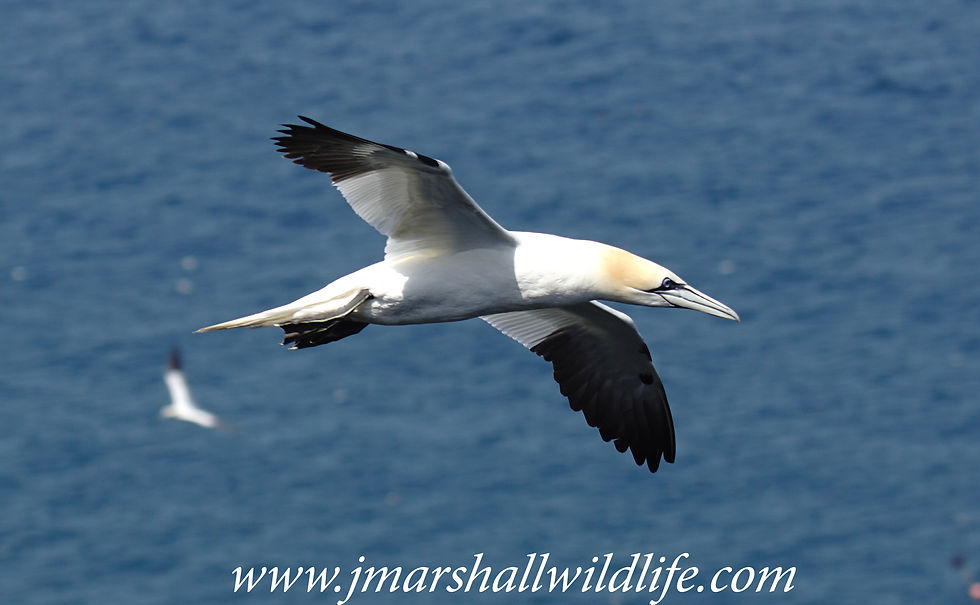
I walked along the cliff tops to the first viewpoint which is called New Roll-Up and from here I could see Gannets, Guillemots, Razorbills, Herring Gulls and Kittiwakes flying past with some turning towards me and landing on the cliffs below. As I moved along the path towards the final viewpoint, I spotted a pair of Corn Buntings in the field to my right as a few Skylarks were singing overhead. The Corn Buntings flew off before I could get a picture so I now walked along to the Staple Newk Viewpoint where I could see hundreds of birds flying past.
There were quite a few Gannets perched on the tops of the cliff to my left with a few gliding in over the top of them and one eventually landing. It then performed it's greeting ritual with its partner which they do every time they return to land. When Gannets dive for food they can do so from up to 30 metres above the water and at speeds of more than 60 mph. The Gannets continued to fly by in huge numbers and in amongst them I saw a few Kittiwakes and Herring Gulls. Down below me was a large expanse of rock jutting out into the sea which was awash with Gannets and amongst them were a couple of Puffins, Razorbills and Kittiwakes.

After a few minutes I spotted a Fulmar as it flew past, almost over my head and a short time later two more Fulmars went past as I turned and headed back along the path towards the visitor centre. I now walked up the path alongside the hedge to the visitor centre and halfway up the Whitethroat was there again, this time giving spectacular views as it sang away from the top of the hedge. A Linnet briefly joined in the singing from a few metres further down the hedge and after a couple of minutes I left the Whitethroat singing away and headed back through the visitor centre to a small area with bird feeders close to the car park. There a few Jackdaws chasing off Tree Sparrows anytime they came near the feeders and around a small pond were a quartet of young Moorhens as I headed back to the car and started my journey home.
I have attached a few photos and a full sightings list from my visit to RSPB Bempton Cliffs.















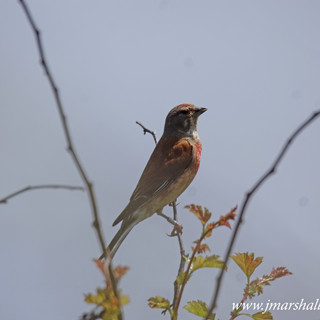









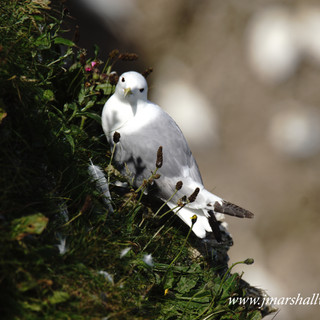







































































































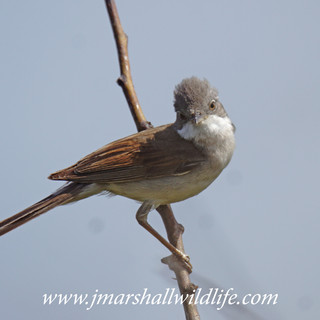





















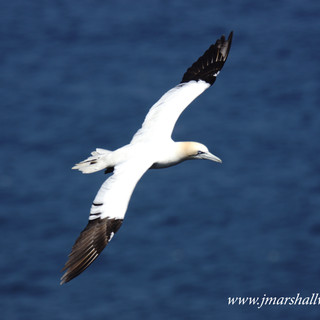















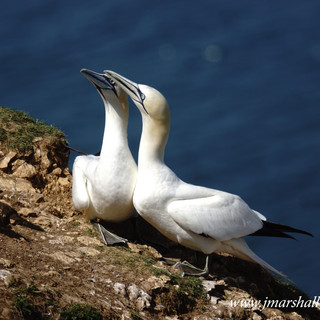













































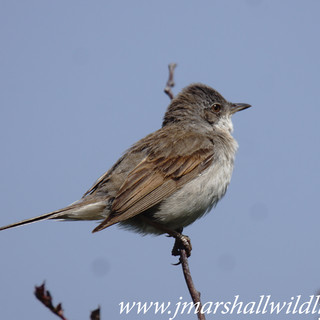




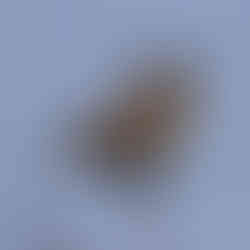































Comments